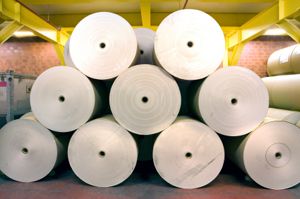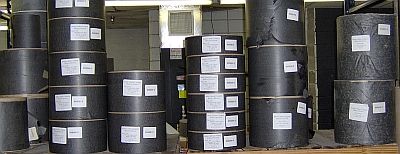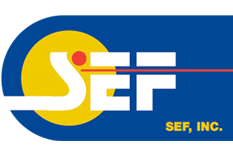
Paper: Paper is the most common substrate for business forms. It is a renewable and recyclable resource and has many qualities that make it an excellent choice for printing. The chief of these qualities being excellent ink absorption. This quality is enhanced by the addition of sizing to the paper. Sizing usually consists of pigments and starches that keep ink on the paper from absorbing too quickly into the paper fibers and bleeding or “feathering out”.
Various types of paper are used to produce business forms and will be discussed in detail in the following sections
Bond Paper
Bond Paper is the most common form of paper used in business today. Applications include copy paper, business forms, and letterhead which utilize bond papers. Bond paper is characterized by its durability, stiffness and a surface that is conducive to pen, pencil and eraser use. It also is compatible with printing by laser and ink jet printers. Bond paper derives its name from the fact that it was originally used for the printing of bonds and stock certificates.
Most business forms are produced on offset bond. This is bond paper that has been treated with “sizing” or various compounds to make the paper more water resistant for the offset printing process. But the paper maintains the essential characteristics that make bond paper so universal in its usage. The standard basis weights for bond paper are 13,16,20,24,28,32,36, and 40 lbs.
Bond is what is known as a “free sheet” paper. During the pulping process the majority of lignin, the natural glue that binds wood together, is removed, leaving only the cellulose fibers. This type of paper is also known by Europeans, as “wood free”. Free sheet paper has a long life because the lignin is what typically causes paper to turn brown and brittle. This is most noticeable in ground wood products such as newsprint which turn brown and brittle in only a short time when exposed to sunlight.
Water Marks
Bond papers are produced as water marked or plain. Typically water marked papers integrate a higher quantity of high quality fiber, such as cotton into their sheet. This fiber will usually account for 25 to 100% of the papers fiber, with the 100% paper usually referred to a 100% cotton rag.
The traditional use of water marked paper was for quality letterhead and other stationery. Today the watermark has been finding a growing acceptance as a security feature on checks and prescription pads.
There are basically two types of water marks, the true or Fourdrinier and the artificial water mark. The true or Fourdrinier water mark is created during the manufacturing process. It presents a pattern which is visible when held up to a light source. The artificial watermark is usually printed using an ink, such as transparent white, that is visible when the paper is held at an angle to the light. The true water mark has been used on bank notes and other documents as a security feature for many years. An artificial water mark can be added to business forms during the manufacturing process. A true watermark must be added to the paper when it is manufactured.
Return To Knowledge Base Start Page
Ledger Paper
Ledger paper has many of the same characteristics of bond paper, but is usually manufactured with a higher basis weight to make it more durable. Among its many uses are financial ledgers, business records and other long term records such as legal documents. Ledger paper has a surface that is very conducive to writing with either a pen or pencil and will also stand up to erasure. It is also able to be utilized in laser and ink jet printers. The paper has a high strength to weight ratio and is stiffer than typical bond papers. The most common basis weights are 24, 28, 32 and 36 lbs.
Return To Knowledge Base Start Page
Carbon Paper

Before the advent of carbonless paper, manifold business forms used carbon to transfer images from part to part. It is still utilized for some applications today, but has been declining in usage for many years. Carbon paper is a light weight paper which has been coated on one side with a combination of wax and carbon black or some other pigment containing compound. When placed between two sheets of paper, the writing on the top sheet is transferred to the bottom sheet. This action creates a “carbon copy” of the text. Carbon interleaved forms are usually limited to being able to legibly transfer only four or five copies in a set. Carbon paper has largely been replaced by copiers, carbonless paper, and electronic formats such as the PDF. SEF, Inc. carries a limited assortment of carbon paper if your customer has an application the requires a carbon interleaved form. Call customer service at 1.800.633.1228 for a quote during our regular office hours or email your request 24 hours a day.
Return To Knowledge Base Start Page
Carbonless Paper
Carbonless papers are bond papers that have been coated with microencapsulated dye and reactive resins and clays. Carbonless papers consist of four distinct types of paper, Coated Back or CB , Coated Front and Back or CFB, Coated Front or CF, and self-contained paper or SC .
If you think of the typical multi-part carbonless form as a sandwich, CB and CF will be your bread with CB as the top slice and CF will be the bottom slice., The CFB will be the filling of the sandwich.. There are occasional variations from this, but as a rule that is the way a form usually is constructed. Carbonless paper is explained in more detail HERE.
Return To Knowledge Base Start Page
Tag Paper
Tag paper is a very dense and smooth paper with high tear resistance. It was originally used to make various hang tags. The two most common colors for tag are white and manila. Tag papers are available in both plain and carbonless. Plain tag usually has a basis weight of 100 lbs. Carbonless tag normally has a basis weight of 105 pounds. Tag can be utilized for forms that need heavy weight paper for things such as integral time cards, diagram areas or parts that will be subjected to heavy usage such as machine shop orders and contractor time and material lists.
